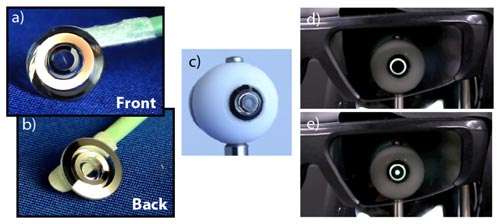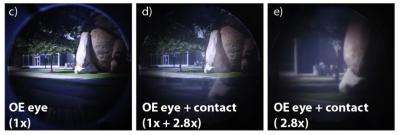A telescope for the eye: New contact lenses may improve sight for macular degeneration patients

Contact lenses correct many people's eyesight but do nothing to improve the blurry vision of those suffering from age-related macular degeneration (AMD), the leading cause of blindness among older adults in the western world. That's because simply correcting the eye's focus cannot restore the central vision lost from a retina damaged by AMD.
Now a team of DARPA-funded researchers from the United States and Switzerland led by University of California San Diego Professor Joseph Ford has created a slim, telescopic contact lens that can switch between normal and magnified vision. With refinements, the system could offer AMD patients a relatively unobtrusive way to enhance their vision. The team reports its work today in the Optical Society's (OSA) open-access journal Optics Express.
Visual aids that magnify incoming light help AMD patients see by spreading light around to undamaged parts of the retina. These optical magnifiers can assist patients with a variety of important everyday tasks such as reading, identification of faces, and self-care. But these aids have not gained widespread acceptance because they either use bulky spectacle-mounted telescopes that interfere with social interactions, or micro-telescopes that require surgery to implant into the patient's eye.
"For a visual aid to be accepted it needs to be highly convenient and unobtrusive," says co-author Eric Tremblay of the École Polytechnique Fédérale de Lausanne (EPFL) in Switzerland. A contact lens is an "attractive compromise" between the head-mounted telescopes and surgically implanted micro-telescopes, Tremblay says.

The new lens system developed by Ford's team uses tightly fitting mirror surfaces to make a telescope that has been integrated into a contact lens just over a millimeter thick. The lens has a dual modality: the center of the lens provides unmagnified vision, while the ring-shaped telescope located at the periphery of the regular contact lens magnifies the view 2.8 times.
To switch back and forth between the magnified view and normal vision, users would wear a pair of liquid crystal glasses originally made for viewing 3-D televisions. These glasses selectively block either the magnifying portion of the contact lens or its unmagnified center. The liquid crystals in the glasses electrically change the orientation of polarized light, allowing light with one orientation or the other to pass through the glasses to the contact lens.
The team tested their design both with computer modeling and by fabricating the lens. They also created a life-sized model eye that they used to capture images through their contact lens-eyeglasses system. In constructing the lens, researchers relied on a robust material commonly used in early contact lenses called polymethyl methacrylate (PMMA). The team needed that robustness because they had to place tiny grooves in the lens to correct for aberrant color caused by the lens' shape, which is designed to conform to the human eye.
Tests showed that the magnified image quality through the contact lens was clear and provided a much larger field of view than other magnification approaches, but refinements are necessary before this proof-of-concept system could be used by consumers. The researchers report that the grooves used to correct color had the side effect of degrading image quality and contrast. These grooves also made the lens unwearable unless it is surrounded by a smooth, soft "skirt," something commonly used with rigid contact lenses today. Finally, the robust material they used, PMMA, is not ideal for contact lenses because it is gas-impermeable and limits wear to short periods of time.
The team is currently pursuing a similar design that will still be switchable from normal to telescopic vision, but that will use gas-permeable materials and will correct aberrant color without the need for grooves to bend the light. They say they hope their design will offer improved performance and better sight for people with macular degeneration, at least until a more permanent remedy for AMD is available. This ongoing research is funded as part of a larger DARPA research program called SCENICC, for "Soldier Centric Imaging with Computational Cameras."
"In the future, it will hopefully be possible to go after the core of the problem with effective treatments or retinal prosthetics," Tremblay says. "The ideal is really for magnifiers to become unnecessary. Until we get there, however, contact lenses may provide a way to make AMD a little less debilitating."
More information: Optics Express, Vol. 21, Issue 13, pp. 15980-15986 (2013). doi: 10.1364/OE.21.015980
















